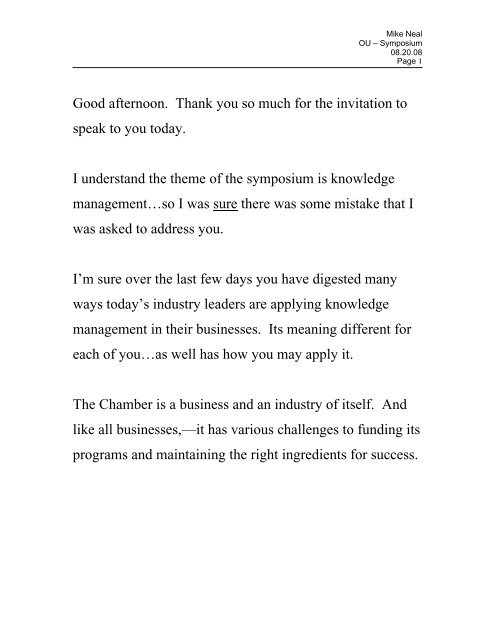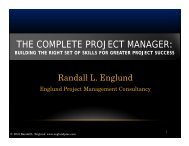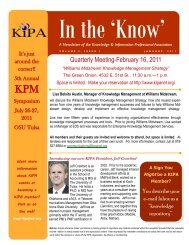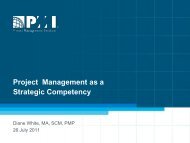Keynote Speaker
Keynote Speaker
Keynote Speaker
Create successful ePaper yourself
Turn your PDF publications into a flip-book with our unique Google optimized e-Paper software.
Mike Neal<br />
OU – Symposium<br />
08.20.08<br />
Page 1<br />
Good afternoon. Thank you so much for the invitation to<br />
speak to you today.<br />
I understand the theme of the symposium is knowledge<br />
management…so I was sure there was some mistake that I<br />
was asked to address you.<br />
I’m sure over the last few days you have digested many<br />
ways today’s industry leaders are applying knowledge<br />
management in their businesses. Its meaning different for<br />
each of you…as well has how you may apply it.<br />
The Chamber is a business and an industry of itself. And<br />
like all businesses,—it has various challenges to funding its<br />
programs and maintaining the right ingredients for success.
Mike Neal<br />
OU – Symposium<br />
08.20.08<br />
Page 2<br />
Since its inception in 1903, the Tulsa Metro Chamber has<br />
played a part in nearly every major community and state<br />
initiative.<br />
Although the extraordinary story of Tulsa’s development is<br />
chronicled in many forms—such as contemporary<br />
newspaper articles, the memoirs of its leaders, several<br />
“official” histories, and filings of legal transactions—<br />
The most accurate record of what made the city it is today<br />
can be found in a single source: the records of over one<br />
hundred years of the actions of the leaders among the Tulsa<br />
Metro Chamber.<br />
You see, knowledge management is not only the process of<br />
gathering information to make educated decisions today,<br />
but rather it is also the practice of maintaining critical<br />
knowledge…from yesterday.
Mike Neal<br />
OU – Symposium<br />
08.20.08<br />
Page 3<br />
Without the Chamber setting in motion a score of crucial<br />
initiatives….there would simply be no Tulsa as we know it<br />
today.<br />
Historians say it might have grown little beyond the 1,400<br />
residents that lived here in 1900. That was the fate of many<br />
neighboring communities…<br />
But that was not what Tulsa—its leaders—wanted the<br />
community to be.<br />
An understanding of the pivotal events that have shaped<br />
Tulsa may be unclear to today’s generation, but it’s the<br />
dedicated practice to knowledge management—<br />
exemplified through a century of minutes and publications<br />
of the Tulsa Metro Chamber—that is now the script that<br />
traces the building of an American city.
Mike Neal<br />
OU – Symposium<br />
08.20.08<br />
Page 4<br />
We know there are lessons to be learned from the legacy of<br />
the past in order to shape today’s future.<br />
Through all of the trials and successes of a day, a week, a<br />
year or even a decade—the Tulsa Metro Chamber<br />
continually identifies ways to make our economy more<br />
diverse, our jobs more plentiful, our workforce more<br />
prosperous and our schools more competitive. In other<br />
words, we provide community assurance that our region’s<br />
quality of life will remain at an optimal level.<br />
The greater Tulsa region and much of Northeast Oklahoma<br />
is the Chamber’s product.<br />
And like many of you in the private sector, our product<br />
must continually evolve to remain competitive in today’s<br />
marketplace.
Mike Neal<br />
OU – Symposium<br />
08.20.08<br />
Page 5<br />
Projects devised to improve our product may remain the<br />
same for decades—for example, the successful completion<br />
of the McClellan-Kerr Navigational System and the<br />
opening of the Tulsa Port of Catoosa was the number one<br />
priority for Chamber leadership for six decades. That’s<br />
right—more than 60 years of planning.<br />
Volunteers changed, staff changed and elected officials<br />
changed, but the goal remained constant. The knowledge<br />
base passed from generation to generation throughout the<br />
process.<br />
Another example—it’s been 20 years since this community<br />
made the last significant investment in the Arkansas River.<br />
Under the leadership of Mayor Inhofe—a low water dam<br />
was built and Zink Lake developed along with the<br />
construction of the River Parks Amphitheater.
Mike Neal<br />
OU – Symposium<br />
08.20.08<br />
Page 6<br />
And we’ve been planning to do more ever since.<br />
There are additional lessons learned along the way and<br />
more than one single entity remained in possession of that<br />
knowledge.<br />
And when it’s time…how do we—as a community—begin<br />
the discussions of plans buried for decades<br />
The Chamber’s unique form of knowledge management is<br />
also in the form of assembling our community partners.<br />
Typically tied to organizational objectives such as<br />
improved performance, competitive advantage, innovation,<br />
developmental processes, lessons learned transfer and the<br />
general development of collaborative practices—the most
Mike Neal<br />
OU – Symposium<br />
08.20.08<br />
Page 7<br />
basic form of knowledge management is illustrated in the<br />
Chamber’s recent strategic planning process.<br />
The 2007 – 2012 five-year strategic plan was developed<br />
through a year-long, facilitated process with input from our<br />
volunteer leadership, staff, and the Chamber’s community<br />
partners—such as the City of Tulsa, Tulsa County, INCOG,<br />
surrounding communities, and area chambers.<br />
When many people come together to meet objectives,<br />
something magical happens—creativity, an expansion of<br />
ideas, new approaches and a plan for bigger results.<br />
Through the process we identified three roles in which the<br />
Chamber plays a part in the community:<br />
As a collaborator or convener—the Chamber can support<br />
an initiative by fostering collaboration across diverse<br />
interest groups.
Mike Neal<br />
OU – Symposium<br />
08.20.08<br />
Page 8<br />
If another entity has taken the lead on an issue, but needs<br />
the resources of the Chamber…then we will do what we<br />
can if possible to help leverage their position.<br />
If the Chamber takes the lead on an initiative--we will also<br />
accept the responsibility and accountability to assure a<br />
successful outcome.<br />
Simply stated:<br />
The Tulsa Metro Chamber will lead, leverage and<br />
collaborate in order to effect change in the Tulsa metro<br />
region.<br />
Through a new strategic plan, we have narrowed our focus<br />
and committed resources to seeing through a plan for the<br />
following five key initiatives and more.<br />
Our first is Jobs and People.
Mike Neal<br />
OU – Symposium<br />
08.20.08<br />
Page 9<br />
It’s a new era of economic development and today’s market<br />
demands an equal balance between recruitment of jobs and<br />
recruitment of people.<br />
One of the most critical issues facing our businesses today<br />
in Northeast Oklahoma is the inability to find and hire<br />
workers of all levels.<br />
Tulsa’s job market is growing at a faster pace than the rest<br />
of the nation which is certainly good news.<br />
In 2007, we ended the year with a positive net job growth<br />
of 6,100. In 2006 we were up 10,500 net new jobs.<br />
In 2005, the Chamber launched a program called Tulsa’s<br />
Future a five-year program to create twenty-six thousand<br />
jobs—of which ten thousand are high value jobs with<br />
minimum annual salaries of $45,500.
Mike Neal<br />
OU – Symposium<br />
08.20.08<br />
Page 10<br />
In 2007, Tulsa’s Future assisted in the creation of 4,922<br />
direct jobs, of which 3,204 equaled or exceeded the<br />
$45,500 minimum salary needed to qualify as high-value<br />
jobs. In fact, the average salary of these jobs is $59,903.<br />
Year-to-date, the Chamber has assisted with three new<br />
locations and 21 expansion announcements. These projects<br />
will create 2,795 jobs, of which 1,534 exceed the $45,000<br />
minimum salary goal.<br />
The results speak for themselves.<br />
The Tulsa metro region perfectly balances convenience and<br />
affordability with the advantages of a talented workforce, a<br />
central location, and a pro-business atmosphere which<br />
makes the region an ideal home for progressive companies<br />
competing in a global economy.
Mike Neal<br />
OU – Symposium<br />
08.20.08<br />
Page 11<br />
However, we can’t create new jobs unless we have a<br />
talented and skilled workforce.<br />
Which leads me into our second initiative: education.<br />
Education is our pipeline supplier for all employers and is<br />
our best opportunity to remain competitive in today’s<br />
marketplace.<br />
It is our goal to make the Tulsa region an innovative leader<br />
in workforce preparation by working hand-in-hand with our<br />
secondary education system to ensure we are supplying our<br />
businesses with the skilled employees they need to grow.<br />
These efforts will range from early childhood, to K-12, to<br />
higher education. We need to improve the graduation rate<br />
and encourage enrollment in a stronger curriculum to<br />
prepare our children to become career students.
Mike Neal<br />
OU – Symposium<br />
08.20.08<br />
Page 12<br />
Furthermore, we need to work closely with area businesses<br />
to encourage employees to return to school for further<br />
training and education.<br />
The new superintendent for Tulsa Public Schools visited<br />
with our Board leadership on Monday and we look forward<br />
to expanding our visibility and our assistance in the coming<br />
months.<br />
Our third initiative is Legislative Success.<br />
Last year, we made great strides in creating one, unified<br />
voice to represent our region at the State Capital and in<br />
Washington, D.C.<br />
The end of the 2008 legislative session is by far one of the<br />
most successful in the Tulsa region’s history.
Mike Neal<br />
OU – Symposium<br />
08.20.08<br />
Page 13<br />
In the final days, the Chamber productively advocated on<br />
behalf of all three bond proposals to adequately fund<br />
transportation infrastructure, higher education and local<br />
projects for Tulsa, Oklahoma City and rural communities.<br />
Work to formulate the 2009 Legislative Agenda continues<br />
at the Chamber’s Regional Business Summit next Tuesday,<br />
August 26 at the Gilcrease Museum. The Chamber will<br />
host all of our regional partners and elected officials to<br />
design the local, state and federal agendas.<br />
This leads me into our fourth initiative…Community<br />
Development and specifically the development of the<br />
Arkansas River corridor, which remains a top priority for<br />
the Chamber and our leadership.<br />
In my experience, there is not a single urban area in<br />
America that has not been successful after dedicating<br />
resources to develop its riverfront. The Arkansas River is
Mike Neal<br />
OU – Symposium<br />
08.20.08<br />
Page 14<br />
the heart and soul of our community and is what connects<br />
us.<br />
Our leadership is resolute. Planning will continue and the<br />
opportunity to develop the river will happen again in the<br />
coming years.<br />
And finally, our last initiative is downtown revitalization.<br />
Research shows that a healthy and vibrant downtown<br />
boosts the economic health and quality of life in a<br />
community.<br />
Specifically, it creates jobs, incubates small businesses,<br />
reduces sprawl, protects property values, and increases the<br />
community’s options for goods and services.<br />
Simply put…these are signs of life in urban areas. I<br />
certainly saw that where I came from in Nashville.
Mike Neal<br />
OU – Symposium<br />
08.20.08<br />
Page 15<br />
The heart of our region is Tulsa, and as Tulsa goes, so goes<br />
the region. And as the region goes, so goes Tulsa.<br />
It took public and private efforts to pass Vision 2025 to<br />
fund the BOK center and rehab the convention center, but<br />
the work is not done.<br />
We must turn a business-centric center that appears dead<br />
after dusk into a vibrant 24/7 metropolis bustling with<br />
residents, restaurants, retail and entertainment.<br />
If we are going to accomplish any of these initiatives it will<br />
be through building relationships, fostering communication<br />
and providing cooperation.<br />
This strategic plan has provided staff and volunteers clear,<br />
measurable goals to benefit our members and the<br />
communities we represent.
Mike Neal<br />
OU – Symposium<br />
08.20.08<br />
Page 16<br />
Paramount to the early success of implementing the plan<br />
has been regular staff and volunteer updates and reviews<br />
using a dashboard approach for reporting.<br />
Statements of End Result, Goals, Objectives, Strategic<br />
Dimensions, Accountability Stakeholders, Target Dates,<br />
and Target measures has become engrained as part of our<br />
knowledge management system.<br />
We will be able to track the progress of these strategic<br />
initiatives throughout the years, while also recording new<br />
chapters of information to be shared with future<br />
generations.
Mike Neal<br />
OU – Symposium<br />
08.20.08<br />
Page 17<br />
I will gladly stop and entertain some questions regarding<br />
the Chamber or our initiatives…







